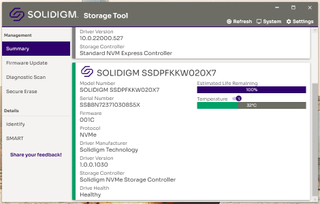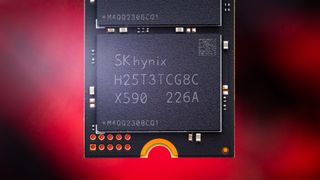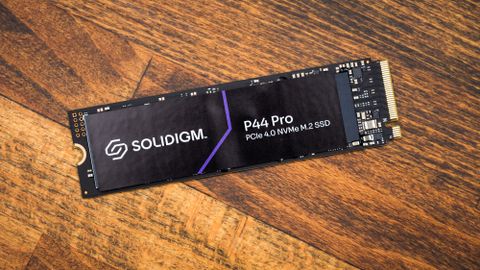Tom's Hardware Verdict
The 1TB Solidigm P44 Pro is a top-tier PCIe 4.0 SSD that matches the Platinum P41 in basically every way. It has the advantages of better pricing and availability, plus Solidigm’s software support. It’s easy to recommend.
Pros
- +
Class-leading all-around performance at 1TB
- +
Strong sustained performance
- +
Power-efficient
- +
Good support
- +
Reasonable MSRP
Cons
- -
Could use a heatsink
- -
No 4TB option
Why you can trust Tom's Hardware
January 3, 2023 Update: We've added new testing for the 1TB Solidigm P44 Pro SSD on page 2.
Original Review published December 13, 2022:
The Solidigm P44 Pro is an SK hynix Platinum P41 by another name. That drive was the fastest drive we had ever tested when it launched and is now just slightly surpassed by the much-more-expensive Samsung 990 Pro. By being under the Solidigm umbrella, the P44 Pro has access to a full software suite and also arrives with a significantly lower MSRP than the Platinum P41 at all capacities.
While there are some minor firmware tweaks, the overall performance remains about the same with the added benefit that this drive should see better global availability. Designed to compete with the best SSDs, the P44 Pro also lacks an option for a heatsink but is otherwise an excellent choice for most applications.
Specifications for Solidigm P44 Pro
| Product | 512GB | 1TB | 2TB |
|---|---|---|---|
| Pricing | $79.99 | $129.99 | $219.99 |
| Form Factor | M.2 2280 | M.2 2280 | M.2 2280 |
| Interface / Protocol | PCIe 4.0 x4 / NVMe 1.4 | PCIe 4.0 x4 / NVMe 1.4 | PCIe 4.0 x4 / NVMe 1.4 |
| Controller | SK hynix Aries | SK hynix Aries | SK hynix Aries |
| DRAM | SK hynix LPDDR4 | SK hynix LPDDR4 | SK hynix LPDDR4 |
| Memory | SK hynix 176L TLC | SK hynix 176L TLC | SK hynix 176L TLC |
| Sequential Read | 7,000 MBps | 7,000 MBps | 7,000 MBps |
| Sequential Write | 4,700 MBps | 6,500 MBps | 6,500 MBps |
| Random Read | 960,000 IOPS | 1,400,000 IOPS | 1,400,000 IOPS |
| Random Write | 1,000,000 IOPS | 1,300,000 IOPS | 1,300,000 IOPS |
| Security | AES-256 | AES-256 | AES-256 |
| Endurance (TBW) | 500TBW | 750TBW | 1200TBW |
| Part Number | SSDPFKKW512H7X1 | SSDPFKKW010X7 | SSDPFKKW020X7 |
| Warranty | 5-Year | 5-Year | 5-Year |
The Solidigm P44 Pro is available at 512GB, 1TB, and 2TB. This is slightly different from the Platinum P41 which had a bit more overprovisioning. In practice, this does not translate to any significant difference in the user experience. It’s the same amount of flash, with just a bit more available to the user with the P44 Pro. Maintaining some free space on any SSD is recommended and, in daily use, there will not be any apparent difference between these two drives. The MSRP is $79.99, $129.99, and $219.99 for the three launch capacities, all significantly lower than the Platinum P41.
Otherwise, the P44 Pro matches the specifications of the Platinum P41, with up to 7,000/6,500 MBps for sequential read and write. IOPS are not officially listed but theoretically it should hit the 1.4 million/1.3 million IOPS for read and write like the Platinum P41. AES-256 encryption is supported as is TCG Pyrite. Solidigm backs this drive with a 5-year warranty and 500TB, 750TB, and 1200TB of writes for each capacity. This is a PCIe 4.0 drive in the M.2 2280 form factor but will still work great in a 3.0 slot.
Software and Accessories for Solidigm P44 Pro

The P44 Pro has three downloadable pieces of software: the Solidigm Storage Driver, the Solidigm Bootable Firmware Update Tool, and the Solidigm Storage Tool. We covered these in our Solidigm P41 Plus review with particular attention on the driver as it allows host-managed caching (HMC) for the P41 Plus.
The Bootable Firmware Update Tool allows you to update Solidigm SSD firmware via bootable USB or optical media. The Solidigm Storage Tool also allows the updating of firmware, including with a command-line interface (CLI), but offers a GUI that details the health and features of the SSD.
A Closer Look at Solidigm P44 Pro




The Solidigm P44 Pro looks almost identical to the Platinum P41. It’s a single-sided drive with a controller, DRAM, and two NAND packages.
Some minor changes are apparent with the power management circuitry, but such analysis is outside the scope of this review. More generally, it’s possible to have either a discrete solution using multiple components or something tighter with a power management integrated circuit (PMIC). There are differences in terms of cost and board space required, but the current PMIC supply crunch probably makes this drive’s design a bit easier to produce in numbers. Manufacturers like Phison make their own PMICs but generally are licensing out the controller as well.


For the full technical details of SK hynix’s controller and flash, please see our Platinum P41 review. The Aries is a powerful controller that raised IOPS performance to new heights, perhaps only beaten by Samsung’s Pascal on the 990 Pro. This level of performance is extraordinary for a consumer drive, but future developments such as Microsoft’s DirectStorage will be more demanding on SSDs.
Solidigm is using SK hynix’s LPDDR4 for the drive’s DRAM cache with 2GB of memory being plenty for a 2TB drive. We like seeing this amount of DRAM, and anything that can offer a bit of power savings is also welcome.

The flash is identical to that found in the Platinum P41: 176-layer TLC. This is generationally up-to-date and it will be some time before we see more layers in full production due to unfavorable market conditions.
Solidigm also has its own flash, such as the 144-layer QLC inherited from Intel on the P41 Plus, a situation that may confuse some, especially as SK hynix has demonstrated 176-layer QLC with a different architecture. Further confusion is brought on by the Solidigm P41 Plus having a similar name to the Platinum P41. With the P44 Pro, this finally goes away, but it may be best thought of as a wider-circulated Platinum P41.
MORE: Best SSDs
MORE: Best External SSDs and Hard Drives
MORE: How We Test HDDs And SSDs
MORE: All SSD Content

Shane Downing is a Freelance Reviewer for Tom’s Hardware US, covering consumer storage hardware.
-
cyrusfox Refreshing to see a top end drive from Solidigm, although odd. As this is the P41 with Solidigm software and controller tuning. I would have thought they would repurpose their own NAND rather than used Hynix.Reply
Nice aggressive initial pricing as well for a top tier drive, this should be able to be found cheaper than the other 3 tops contenders (Sn850, 990 pro, & P41). Whatever happened to Kioxia(Toshiba) or Micron, they seem absent from the top of the line consumer pcie gen 4 ssd competition. Crucial P5 can't compete, not seeing any entries from Kioxia. -
anonymousdude Replycyrusfox said:Refreshing to see a top end drive from Solidigm, although odd. As this is the P41 with Solidigm software and controller tuning. I would have thought they would repurpose their own NAND rather than used Hynix.
Nice aggressive initial pricing as well for a top tier drive, this should be able to be found cheaper than the other 3 tops contenders (Sn850, 990 pro, & P41). Whatever happened to Kioxia(Toshiba) or Micron, they seem absent from the top of the line consumer pcie gen 4 ssd competition. Crucial P5 can't compete, not seeing any entries from Kioxia.
I think you may be misunderstanding the relationship between some of these companies. Solidigm is a subsidiary of SK Hynix created as a result of acquiring Intel's flash and ssd division, which to my knowledge was only making QLC NAND and Optane anyways. No controller either. So it's not weird at all that they use TLC Hynix flash and controller.
As for pricing, it is very competitive. The closest one at msrp is the P41 and that's $260. Granted these go on sale fairly frequently. Like the 2TB SN850x and P41 were $160 or so during Black Friday. I see the P41 pop up for around $210 too.
Kioxia doesn't really release to retail like this much anymore. They do have retail products, just not in high volume nor are competitively priced. Their history is fun too. WD acquired SanDisk back in 2016, who had a joint venture with Toshiba (Kioxia) for NAND fabrication and development which continues to this day. So WD drives have a custom controller with Kioxia's BICs NAND. You'll see the Kioxia name often though in pre-builts and laptops cause that's their target market.
Micron (Crucial) released the P5 Plus last year and it targeted the top 4.0 drives at that time. So the 980 Pro, SN850, and your pick of Phison E18 drive. It was competitive at that time and with its recent pricing is still a great value. It just so happens that everyone updated their drives this year. Samsung 990 Pro and WD SN850x. SK Hynix releases the P41 beginning of the year and now Solidigm with the P44. So mostly a case of bad timing on Micron's part is what gives you that feeling. -
thestryker It's not clear in the review whether or not the Solidigm Driver is used on the test system. Assuming it was were any tests done without it to see if it has an impact (or if it wasn't were any done with it)? I generally don't install storage drivers/software unless there's a specific reason to and was considering getting one of these.Reply
It is interesting to see where PCIe 4.0 drive performance has landed. Seems like this, the 990 and P41 will likely be the best choice of drive for some time even with PCIe 5.0 drives coming.
One note on Kioxia: they've been having financial and legal issues which seems to have impacted several of their latest technologies. I don't believe there are any gen1 XL-Flash devices on the market despite having their own line and one from Dapustor. They've even announced a second generation of XL-Flash without any products. -
Udyr I don't know why or how you're getting such high idle temps. My 1TB P41 idles at 27C, with an ambient temp of 24C, sandwiched between the CPU and GPU and no additional airflow other than the front fans.. When I had to transfer all my backup data (~700GB) from my trusty old HDD, the temperature went up by 12-13C, even after a couple hours of activity. Granted, I didn't run any synthetic benchmark, but seems odd the test yielded such high numbers.Reply -
DavidLejdar Nice. I have only one M.2 slot left, and looking to use that for a 4 TB drive eventually. But the test results seem to say that one shouldn't really see a difference between P44 Pro and i.e. 990 Pro in everyday use.Reply
And the cheaper price makes upgrading more affordable, which in turn means proliferation, which in turn means even more game devs making use of NVMe bandwidth, which in turn means that I may benefit too. :)
Udyr said:I don't know why or how you're getting such high idle temps. My 1TB P41 idles at 27C, with an ambient temp of 24C, sandwiched between the CPU and GPU and no additional airflow other than the front fans.. When I had to transfer all my backup data (~700GB) from my trusty old HDD, the temperature went up by 12-13C, even after a couple hours of activity. Granted, I didn't run any synthetic benchmark, but seems odd the test yielded such high numbers.
Even an active cooling for SSD may rely on there being air flow, like in a wind tunnel, which the test-rig apparently didn't have. And the heat-buildup near a SSD without such air flow, it may not really be that large for some convective heat dissipation to be going on. Well, at least that would be my guess about what could be a factor in regard to idle temperature. As for operating temperature, HDD can do around 100 MB/s (plusminus), and that's not really pushing a NVMe SSD, even if it took some time to move all that data. -
ReallyBigMistake solidigm is pronounced saa-luh-dime]I would have never figured that outReply
I can't wait for PCIe 5.0 SSDs to finally come out. -
DVDRDog I have to question where Shane got his specs for the Solidgn SSD's. For example he states warranty TBW. That seems to be the biggest secret on the Internet. Not even on the manufacturer's site is the warranted TBW for their Intel inherited SSD line. Does Shane Downing have some spiritual connection with SK Hynix and he has uncovered the big secret or is he fudging the numbers? I challenge Shane to back up his info with something legally binding in writing from the manufacturer or save this kind of speculation to social media where it belongs.Reply -
TesseractOrion Would a heatsink be recommended for a well ventilated case? I have six fans on various sides (front, top, bottom & back), but the NvME 4.0 slot is next to CPU and under GPU (though could move that).Reply
I have an AMD 5700X but only a Radeon 580X paired with it.
